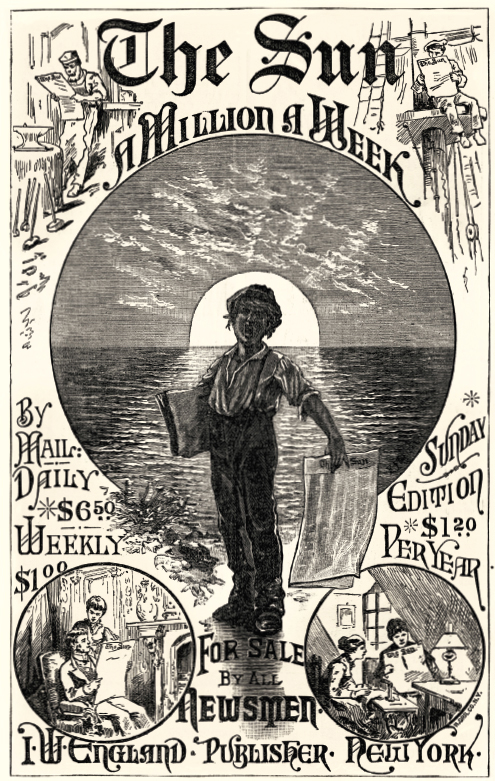The Penny Press: Becoming a Mass Medium
Printed Page 65
During the 1830s, a number of forces transformed newspapers into an information source available to, valued by, and affordable for all—a true mass medium. For example, thanks to the Industrial Revolution, factories could make cheap, machine-made paper to replace the expensive handmade kind previously in use. At the same time, the rise of the middle class, enabled by the growth of literacy, set the stage for a more popular and inclusive press. And with steam-powered presses replacing mechanical presses, publishers could crank out as many as four thousand copies of their newspapers every hour, which dramatically lowered their cost. Popular penny papers soon began outselling the six-cent elite publications previously available.

The First Penny Papers
In 1833, printer Benjamin Day founded the New York Sun, lowered the price of his newspaper to one penny, and eliminated subscriptions. The Sun (whose slogan was “It shines for all”) highlighted local events, scandals, and police reports. It also ran fabricated and serialized stories, making legends of frontiersmen Davy Crockett and Daniel Boone and blazing the trail for Americans’ enthusiasm for celebrity news. Within six months, the Sun had a circulation of eight thousand—twice that of its nearest competitor. The Sun’s success unleashed a barrage of penny papers that favored human-interest stories: news accounts that focused on the daily trials and triumphs of the human condition, often featuring ordinary individuals who had faced down extraordinary challenges.
In 1835, James Gordon Bennett founded another daily penny paper, the New York Morning Herald. Considered the first U.S. press baron, Bennett—and not any political party—completely controlled his paper’s content. He established an independent publication that served middle- and working-class readers. The Herald carried political essays and reports of scandals, business stories, a letters section, fashion notes, moral reflections, religious news, society gossip, colloquial tales and jokes, sports stories, and, later, reports from the Civil War fronts. By 1860, the Herald had nearly eighty thousand readers, making it the world’s largest daily paper.
Changing Business Models
As they proliferated and gained new readers, penny papers shifted their business models. Previously, they had been funded primarily by the political parties that sponsored them, and their content emphasized overt political views. But as they expanded, they realized they could derive even more revenues from the market—by selling space for advertisements and by hawking newspapers on the streets and through newsstands. As their business model shifted, editors began putting their daily reporting on the front page, moving overt political viewpoints to the editorial page.
As ad revenues and circulation skyrocketed, the newspaper industry expanded overall. In 1830, about 650 weekly and 65 daily papers operated in the United States, reaching a circulation of 80,000. Just ten years later, the nation had a total of 1,140 weeklies and 140 dailies attracting more than 300,000 readers.
The First News Wire Service
In 1848, the enormous expansion of the newspaper industry led six New York newspapers to form a cooperative arrangement and found the Associated Press (AP), the first major news wire service. Wire services began as commercial and cooperative organizations that relayed news stories and information around the country and the world using telegraph lines (and, later, radio waves and digital transmissions). In the case of the AP, which functioned as a kind of news co-op, the founding New York papers provided access to their own stories and those from other newspapers.
Such companies enabled news to travel rapidly from coast to coast, setting the stage for modern journalism in the United States. And because the papers still cost only a penny to buy, more people than ever now had access to a widening array of news. Clearly, newspapers had moved from the entrepreneurial stage to the status of mass media.